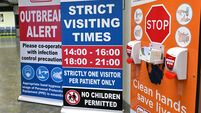Uranium level in well 65 times above safe limit
A statement issued yesterday by the South Western Area Health Board (SWAHB) said 328 people had been screened between July 24 and the start of September. “While the results of the individual tests will be forwarded to the residents’ GPs, the results of the study will be available when the project is completed in early 2004,” the statement said.
The tests were carried out as a precautionary measure, following the discovery by the Environmental Protection Agency (EPA) of uranium levels in a Baltinglass well 65 times above the limit described as safe by the World Health Organisation (WHO).













